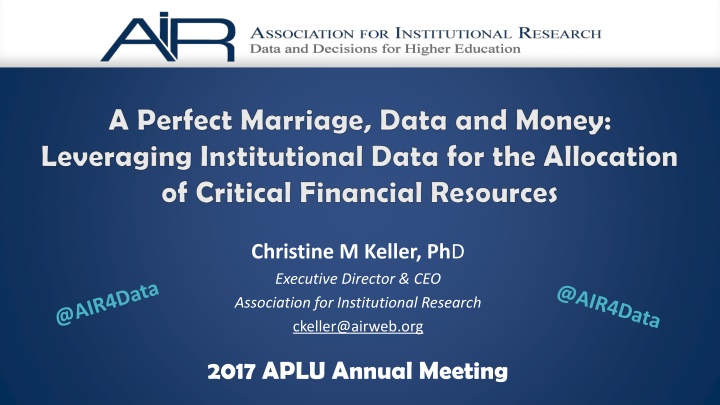Insights into Collaborations between Institutional Research and Business Offices
Explore the valuable collaborations between Institutional Research and Business Offices in higher education institutions, focusing on the types of work, frequency of meetings, use of finance data, key performance indicators, and areas of collaboration such as performance-based funding and economic impact studies.
Download Presentation

Please find below an Image/Link to download the presentation.
The content on the website is provided AS IS for your information and personal use only. It may not be sold, licensed, or shared on other websites without obtaining consent from the author.If you encounter any issues during the download, it is possible that the publisher has removed the file from their server.
You are allowed to download the files provided on this website for personal or commercial use, subject to the condition that they are used lawfully. All files are the property of their respective owners.
The content on the website is provided AS IS for your information and personal use only. It may not be sold, licensed, or shared on other websites without obtaining consent from the author.
E N D
Presentation Transcript
Christine M Keller, PhD Executive Director & CEO Association for Institutional Research ckeller@airweb.org 2017 APLU Annual Meeting
Without data, you're just another person with an opinion
Association for Institutional Research (AIR) Worldwide association of higher education professionals 4000+ members
AIR exists ... so that higher education institutions effectively use institutional research - data, information, and analysis for decision support - in a rapidly changing environment.
2016 Survey Collaborations between IR & the Business Office In what types of work does institutional research collaborate with their institution s business office? How often do representatives from IR and the Business Office meet?
IR Use of Finance Data in Past Year Never 27% 1-2 times 26% 3-5 times 18% More than 5 times 29% Source: AIR Survey, Collaborations between IR and the Business Offices, 2016
How often IR meets with Business Office Never meets 18% Once a year or less 12% Few times per year 38% Meet regularly (at least monthly) 32% Source: AIR Survey, Collaborations between IR and the Business Offices, 2016
KPI development/monitoring Finance & Budget modeling Areas of Collaboration Institutional Research & Business Office ~35% Performance-based funding Cost/Benefit analyses ~25% Economic impact studies Salary equity studies Net price calculators Student borrowing/debt studies Financial aid modeling ~15% ~6% Capital expenditure analyses Source: AIR Survey, Collaborations between IR and the Business Offices, 2016
Areas of Collaboration in Past Year & Meeting Frequency economic impact studies 29% 65% 6% financial aid modeling 21% 64% 14% capital expenditure analyses 43% 57% cost/benefit analyses 39% 57% 4% student borrowing/debt studies 43% 50% 7% net price calculator 43% 50% 7% KPI development & monitoring 39% 49% 5% 7% performance-based funding 44% 48% 4% 4% finance & budget modeling 44% 47% 6% 3% salary equity studies 54% 23% 15% 8% Never meet Meet rarely Meet few times a year Meet regularly Source: AIR Survey, Collaborations between IR and the Business Offices, 2016
How should institutional research and business offices collaborate? Study effect of budgeting decisions on student outcomes Create program viability measures Develop institutional performance indicators Examine cost/benefit of potential new revenue streams Analyze impact of student retention on institution s financial health Combine financial data with enrollment reporting Source: AIR Survey, Collaborations between IR and the Business Offices, 2016
Example: University of Washington - Bothell Introduction of RCM budgeting IR role Develop tools to show connections among functional areas Training deans, chairs Meet bi-weekly with finance Goal: move from comfort with tools to using what-if scenarios for planning
Learn more: https://events.educause.edu/enterprise-it-summit/2018























